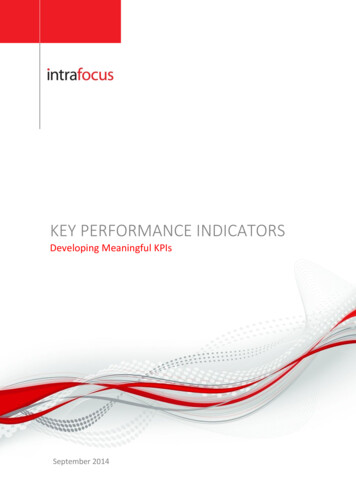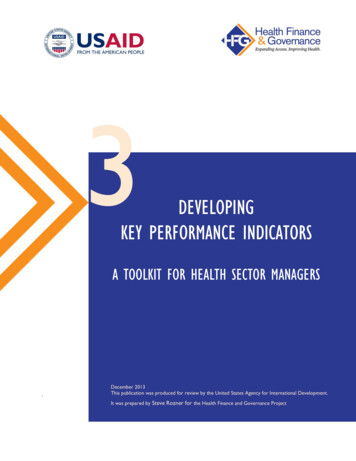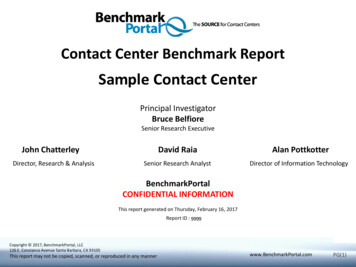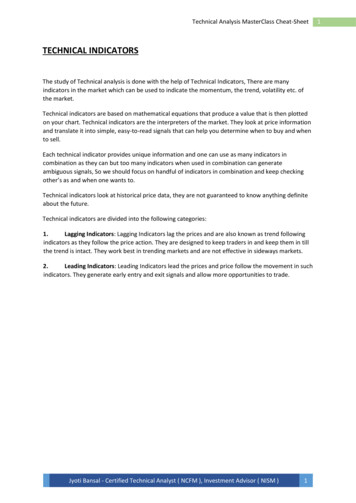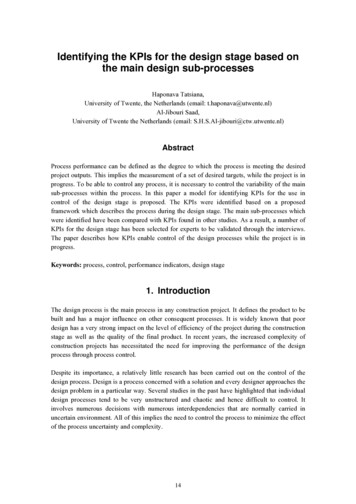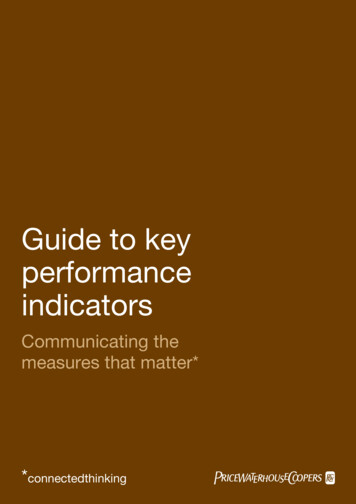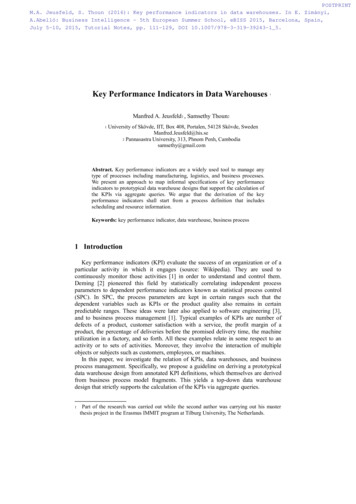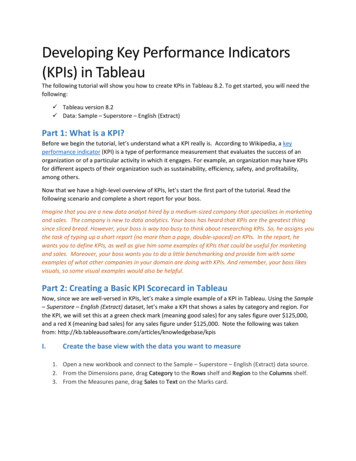
Transcription
Developing Key Performance Indicators(KPIs) in TableauThe following tutorial will show you how to create KPIs in Tableau 8.2. To get started, you will need thefollowing: Tableau version 8.2 Data: Sample – Superstore – English (Extract)Part 1: What is a KPI?Before we begin the tutorial, let’s understand what a KPI really is. According to Wikipedia, a keyperformance indicator (KPI) is a type of performance measurement that evaluates the success of anorganization or of a particular activity in which it engages. For example, an organization may have KPIsfor different aspects of their organization such as sustainability, efficiency, safety, and profitability,among others.Now that we have a high-level overview of KPIs, let’s start the first part of the tutorial. Read thefollowing scenario and complete a short report for your boss.Imagine that you are a new data analyst hired by a medium-sized company that specializes in marketingand sales. The company is new to data analytics. Your boss has heard that KPIs are the greatest thingsince sliced bread. However, your boss is way too busy to think about researching KPIs. So, he assigns youthe task of typing up a short report (no more than a page, double-spaced) on KPIs. In the report, hewants you to define KPIs, as well as give him some examples of KPIs that could be useful for marketingand sales. Moreover, your boss wants you to do a little benchmarking and provide him with someexamples of what other companies in your domain are doing with KPIs. And remember, your boss likesvisuals, so some visual examples would also be helpful.Part 2: Creating a Basic KPI Scorecard in TableauNow, since we are well-versed in KPIs, let’s make a simple example of a KPI in Tableau. Using the Sample– Superstore – English (Extract) dataset, let’s make a KPI that shows a sales by category and region. Forthe KPI, we will set this at a green check mark (meaning good sales) for any sales figure over 125,000,and a red X (meaning bad sales) for any sales figure under 125,000. Note the following was takenfrom: se/kpisI.Create the base view with the data you want to measure1. Open a new workbook and connect to the Sample – Superstore – English (Extract) data source.2. From the Dimensions pane, drag Category to the Rows shelf and Region to the Columns shelf.3. From the Measures pane, drag Sales to Text on the Marks card.
II.Create a calculated field using the Sales figure1. Select Analysis Create Calculated Field.2. In the Calculated Field dialog box, complete the following steps. For Name, type KPI. In the Formula box, build the following formula:IF SUM ([Sales]) 125000 THEN "Above Benchmark" ELSE "Below Benchmark" END3. Confirm that the status message indicates that the formula is valid, and then click OK.Note: You can also write the formula the following, slightly more succinct format:IF SUM([Sales]) 125000 THEN "Above Benchmark", "Below Benchmark" )
III.Create the KPI view from the base view1. On the Marks card, from the drop-down list of views, select Shape.2. From the Measures pane, drag KPI to Shape.3. On the shape legend drop-down menu, select Edit Shape.4. In the Edit Shape dialog box, make the following selections: Under Select Shape Palette, select KPI. Under Select Data Item, select Above Benchmark, and then in the KPI palette, selectthe green check mark. Select Below Benchmark, and then select the red X. Click OK.
5. The shapes in the view show your selections. Now you just need to hide the text labels.6. On the Marks card, click Label, and in the drop-down control, clear the Show mark labels checkbox.7. You can fine-tune how Tableau displays the mark labels by doing the following on the Labeldrop-down control: To show the label for just one mark, under Marks to Label click Highlighted, and thenclick the mark in the view. To show the labels for one or more marks, under Marks to Label click Selected, andthen select the marks in the view.8. Save your worksheet as Sales KPIPart 3: Creating a Profitability KPI DashboardNow that you have seen how to create a simple KPI, let’s move to a more complex set of graphs basedon one KPI that works together in a dashboard. This set of graphs based on the KPI will show
Profitability. The dashboard will be comprised of three graphs, and will use the Sample – Superstore –English (Extract) data source:I.II.III.Profitability by ItemProfitability DetailsProfitability by CategoryI.Profitability by item (Scatterplot)Create Calculated FieldsFirst, let’s create a KPI calculated field called “Profitability KPI” which is based on a Profit Ratio.1. First, create a calculated field with the name “Profit Ratio”. The formula for this is: SUM(Profit)/SUM(Sales) For Profit Ratio, change the Default Properties and Number Format for ProfitRatio to Percentage, with 2 decimal places.2. Next, create a calculated field with the name “Profitability KPI” The formula for this is:IF [Profit Ratio] 0.5 then "AWESOME" elseif[Profit Ratio] 0.3 then "SO-SO" else"BAD" END IMPORTANT NOTE: the above code will assign values for AWESOME, SO-SO, andBAD based on the code. In essence, the KPI is if the Profit Ratio above 0.5 then itis awesome; if the Profit Ratio is above 0.3 but not 0.5, then it is simply so-so;and everything else below 0.3 is not good, or bad. Basically, this KPI schemerepresents the KPI that will govern our analysis, and the assumptions on whichour dashboard and conclusions are based.3. You should now have a Profit Ratio and a Profitability KPI under Measures.Create the Scatterplot Using the Profit Ratio and Profitability KPI1. Drag the Profit Measure into Columns, and the Profit Ratio into Rows2. Drag Item into the Detail box on the Marks Card.
3. Click the Color button in theMarks Card and click Edit Colors4. Select AWESOME and choose thecolor you think representesawesome. I chose Green. Next,select BAD and choose the coloryou think represents bad. I choseRed. Do the same for SO-SO,which I chose as Yellow.5. Click Apply and OK.6. Now in the drop-down menu ofthe Marks Card, select the CircleOption.7. Also change the size of thecircles.8. Save this Sheet as “Profitability by Item”. Your graph should look something like this:II.Profitability DetailsOn a new Sheet, let’s create a more detailed look at your profitability and items using theProfitability KPI.1. Drag Customer Segment and Category into Rows
2. Notice that Customer ID is under Measures. This really should not bethe case. So drag Customer ID up into Dimensions, and place it underthe Customer folder.3. Drag Customer ID into Rows next to Category. Click Add all Members.4. Now we need some measures. To populate the report: Double-Click Sales Double-Click Profit Double-Click Profit Ratio5. Drag Profitability KPI into the Color button on the Marks Card (Notice that this makes the Profit,Profit Ratio, and Sales Green, Yellow, or Red based on the threshold we created in theCalculated Field.6. Save this sheet as “Profitability Details”. It should look something like this:
III.Profitability DetailsThe last sheet we will make will be a Profitability by Category report that will give us a view of theTotal Profit and Profit Ratio by Category.1. In a new Sheet, drag Category into Rows.2. Double-Click Profit; Double-click Profit Ratio.3. We want to make a quick table calculation for Profit. Remember those? Tableau hasdifferent options for common calculations, which they call “quick table calculations” sothat we don’t have to create a lot of calculated fields.4. We want to see the Percent of Profit alongside our Profit Ratio.5. So, in the Measure Values pane, hover over SUM(Profit), click the down arrow, selectQuick table calculation, and select Percent of Total. BOOM! This will ‘quickly’ calculatethe % of Total Profit for each Category.6. Notice the new name of the Column is “% of Total Profit along Table (Down).” This isWAY too long for us. Let’s rename it to just “% of Total Profit”. Right-click the title, select Edit Alias, rename this to “% of Total Profit” and clickOK. There you have it.7. Now don’t forget about the fact that we are trying to show KPIs. Drag the ProfitabilityKPI Measure to Color. Now we have a visual representation of whether the % of TotalProfit is good or bad, based on the Profit Ratio.8. Save this Sheet as “Profitability by Category”9. Your report should look like this:
IV.Creating the Profitability KPI DashboardNow, it’s that wonderful time to put everything together! Since you are the dashboard expect, I amgoing to let you how to decide to assemble the dashboard, and how you want to make it interactive.I made the following Dashboard below. I expect your Dashboard to have: At least two Actions At least one Quick FilterYou will impress me if: You build another dashboard that links from one to the other. You utilize multiple filters. Your dashboard layout and interactivity tells a simple, but meaningful story aboutprofitability. You go back to the worksheets and add labels (e.g., Customer Name, Customer ID), whichyou could potentially implement a search quick filter based on these items.
Part 4: Write-UpOnce your dashboard is finished, please write a short analysis about your dashboard. In your analysis,include the following points. Please save your write-up as KPI Analysis.docx What the KPI is Why the KPI makes sense or does not make sense (do not just say because I told you to do it.)Am I right in choosing these thresholds? What story the dashboard tells What is another KPI that could be made based on this data?
Tableau version 8.2 Data: Sample – Superstore – English (Extract) Part 1: What is a KPI? efore we begin the tutorial, let’s understand what a KPI really is. According to Wikipedia, a key performance indicator (KPI)
